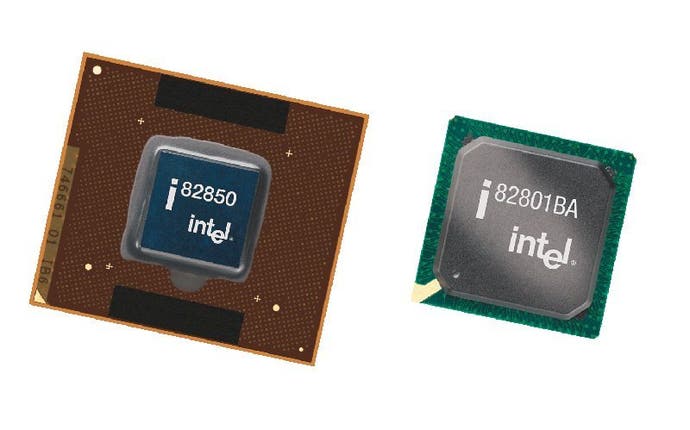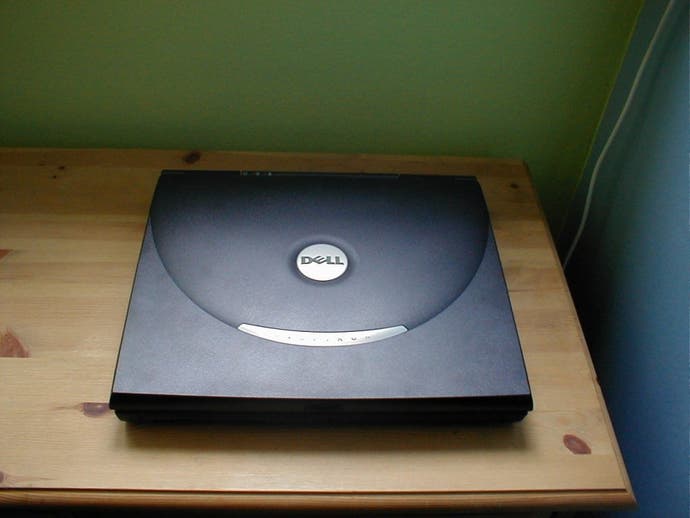Gaming on the Go
Article - new laptop technologies and a look at the high end Dell Inspiron 8000
In the days of yore, a laptop was arguably just a computer with a battery. Often two or more inches thick and with a screen only a quarter the size of the flip top, the idea of trouping around with some of those 'portables' is spine-tingling. Fast forward ten years, and compared to your average laptop, it's the desktop PC that's turned into a clunky, beer-bellied lager lout whose only decent application is in loitering around and causing trouble. Nowadays though, a swanky laptop is the epitome of chic. If you work in New Media, the chances are a wafer-thin Sony VAIO notebook slides comfortably into your briefcase, and if you're a mobile exec, you'll be carrying enough power to embarrass most desktop owners.

Visuals
The problem is, gamers aren't interested in spreadsheets and Word documents, and the speed with which one can load up Internet Explorer. Nor is the average gamer particularly bothered about the prestige and elegance. For most of us, being able to play The Longest Yard in Quake 3 without having to strip things down to primary colours would do. Things have looked promising ever since NVIDIA stopped pouting on the sidelines and decided to make inroads on the graphics card industry. It was only a matter of time before they did something for mobile devices, especially given ATI's flaky Rage Mobility series' performance in this area. The GeForce 2 GO was the product of this, and is gradually now rolling off the production lines in high end desktop replacement laptops. The question is, how good is the GeForce 2 GO, and are there better things to come? To address the first part of the question, the answer is "superb". Compared to the ATI's 32Mb M4 Rage Mobility chip, the GeForce 2 GO pummels benchmarks into submission and sets new highs for performance. Running the two 32Mb graphics monstrosities head to head you wouldn't realise that the M4 was the leading alternative. It simply cannot compete. For ATI though, this will not stand, and that leads us on to the second part of the question. To deal with this outrageous counteraction on NVIDIA's part, ATI intend to build their M4 successor, M9, with its roots firmly in 3D. By basing it on the Radeon desktop chipset, ATI are already boasting what is unquestionably the best 2D quality display out there, and given the Radeon's performance in games, we'll be surprised if NVIDIA are out in front for long. Codenamed the Mobility M9, the Radeon-based technology is being targeted for the second quarter of 2002 to run on DirextX 9, and will include R300 (the successor to the almost-released-but-not-quite Radeon 2) functionality and a 350MHz core on a 0.15micron production process, with memory totals of between 32 and 64Mb. Unfortunately for ATI, NVIDIA may have something planned to compete directly with the Mobility M9. Rumour has it that nForce motherboards from NVIDIA are on their way to laptops, and given the reception nForce received from industry diehards at the recent Computex trade show, ATI must be feeling somewhat uncomfortable. nForce laptops could also include decent quality 3D sound support as well. The company hasn't made an announcement yet, but we suppose they're waiting for ATI to play their hand first.

Processing
Graphics chips aren't the only area of laptops where the market leader is facing stiff competition from an upstart. Intel's grip on the mobile processor market is very strong, but both AMD and Transmeta are giving it some cause for consternation. Transmeta's efforts are the weaker of the two, targeting small (very small) almost handheld laptops with their Crusoe line, but AMD are going in all guns blazing. After relying on their K6-2 line for so long, the company finally has a product to attack Intel with. The Athlon 4, named thus to demonstrate its competition with the Pentium 4 is supposedly a vast improvement over "series III" (e.g. K7/Athlon and Pentium III) processors, so technically AMD has leap-frogged the mobile Athlon altogether. This is why the mobile Athlon is sometimes described as Palomino, the name given to its desktop successor. It's becoming increasingly clear that AMD is in a strong position with the Athlon 4. Benchmarks are promising, and the chip is all set to hit the market in Compaq-based laptops. Even Dell, one of Intel's biggest allies, is having a keen look at them. The mobile Duron will also give Intel a bit of a run for their money. In desktop machines the Duron has annihilated the Celeron, with faster speed grades and benchmarks. Clock for clock the two are no match, and the Duron will therefore lead to some remarkably cheap laptops without much of a performance loss, we'd wager. In answer to all this, Intel is furiously trying to get the mobile Pentium 4 ready, but power consumption and other problems are keeping this from happening. At the moment though, the Pentium III is the chip of choice in laptops, simply because it's there and little else is. Speed grades start at around 700MHz new and go all the way up to 1GHz, with the introduction of slightly faster chips likely in the next year or so. Intel's final revision of the Pentium III, Tualatin will see to that. In an effort to try and stay ahead, some laptop manufacturers have managed to get desktop spec Pentium III chips into laptop designs. PC World's Advent brand laptops hit headlines recently with the announcement of a 1.1GHz processor. It has to be a pretty big box though.

Leader of the pack
At the moment though, there is arguably one true leader in the gaming laptop market, although they probably don't realise it as so. Dell's Inspiron 8000 laptop can be had for as little as £1099 +VAT, quite a lot you might say but a reasonable amount for a laptop, and it comes equipped with a GeForce 2 GO chip, a faster Pentium III processor and a 15.1" TFT screen. This screen is huge, about the size of the screen on a 17" desktop monitor. Remember, desktop monitors are measured from the corner of the plastic to the opposite corner. With TFT displays, it's corner to corner of the actual display. What sets Dell apart though is their willingness to stock the 32Mb GeForce 2 GO part, when most of their competitors are going for 16Mb. Dell's Inspiron 8000, when upgraded to include the 32Mb part, is an absolute stunner. So much so, this writer reasoned, that he ought to buy one. The model I bought is powered by a 700MHz Pentium III, but you can go all the way to 1GHz. Instead of paying Dell's somewhat extortionate rates for SODIMM memory though (you can see why they call it that), I went for 128Mb default and bought a 256Mb stick from Crucial, so I'm currently powered by 384Mb of memory. The GeForce 2 GO, as mentioned above, is a 32Mb variant, and the 15.1" TFT display is crystal clear. Making up the rest of the specs are an 8x DVD-Rom and software encoder, which plays DVDs magnificently, it must be said, as well as all the usual gear and built in 100Mbps networking and 56k modem. The only problem with the Dell range is their battery life. Like most high performance laptops, you get 2 hours or thereabouts. For £70 you can pick up another battery, which can replace the floppy disk in the front expansion bay, but that's still only two DVDs per flight over the Atlantic. Still, I doubt you'll want to haul this out too often on planes let alone public transport; it's a pretty big piece of equipment. For Dell, the Inspiron 8000 is a desktop replacement. You no longer need worry about having a machine back at home, just slap your laptop down, plug in your external monitor, keyboard and mouse and away you go. The docking system (available separately) even has a replacement power button, so you don't have to open the thing up to hit it, and a monitor stand too. For gamers though, the implication is clear. LAN Parties.

Take gaming with you
You may think the purchase of a £1400 laptop is a bit excessive when really you only intend to use it for LAN Parties and the odd bout of Quake with your mate up the road, but in actual fact it's a lifesaver. Until now, if I wanted to settle a little dispute with my friend on Q3Tourney4, one of us had to lug our kit to the other end of the road - an absolute chore and not too bright given the state of my neighbourhood's thieving youngsters. However, with the arrival of the Inspiron 8000, I slide it into its carry case, walk briskly up the road, plug it in and stick some rail bolts through him. All up and running minutes. For LAN Parties like Multiplay's i-series LANs, it will be a godsend. While all your mates are making their third trip out to the MPV to pick up a 19" monitor or a lofty tower case and pillow, you'll be sitting comfortably, fragging away to your heart's content. The only issue is one of performance, which leads us back to the original question that we started out with. How does it perform? Well, the benchmarks are impressive. Using my average display settings for Quake 3 (that's "Normal" at 1024x768 screen resolution) the machine pulled nearly 70 frames per second in the first of the timedemos. That's a pretty high score, given that the GeForce 2 GO is supposedly a little less powerful than a GeForce MX. In 3D Mark 2001 it fairs pretty well, with an index of 2285. Compare that to a desktop machine running a GeForce MX and you'll find that it's quite competitive. All in all, when I set up at my next LAN Party, I fancy I'll find it a lot less back-breaking than the rest of you. The other thing is, I can just hop on the train and I'll be there before I know it, with no motorway hijinx and cars stacked full of PCs to worry about. Bliss. Given the innovations AMD, ATI and NVIDIA have in mind for the laptop market in the next 12 months, you might argue that it's worth waiting. For me though, this laptop runs every game I own and pretty darn well to boot. As far as productivity is concerned, I can take it with me with the minimum of fuss and its big, fast hard drive is perfectly able when it comes to storing all my work. The era of the desktop replacement laptop is ever so nearly here - you'll just have to make your mind up whether or not you want to be part of it.
-

